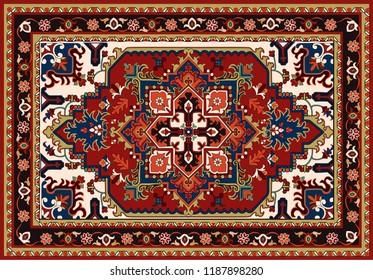Persian Carpets Dubai, Abu Dhabi and Al Ain :- Features of Persian Carpets
In ancient times, Iranian carpets were made using natural dyes such as indigo and cochineal insects. Today, synthetic dyes have also increased their use. Traditional Iranian carpets use natural dyes that come from various plants, such as pomegranate rind, cochineal insects, and pomegranate seeds. The subtle unevenness of a natural dyed carpet means that it is made using natural dyes.
The earliest known Persian carpet
The earliest known Persian carpet was found in the Altai Mountains in 1949 by Russian archeologist Rudenko. The Pazirik Kilim is a 5-kilometer-long rug that has a dark red paint. It features two wide borders, one depicting a roe deer and the other a pair of Iranian horsemen. Scientific tests conducted in Switzerland and Russia determined that this carpet dated between 383-200 BC.
Rugs woven around the city of Kerman
The Persian word boteh means palm leaf or immature flower. This design is used throughout the carpet belt. The most complex boteh is found on rugs woven around the city of Kerman. The Persian language also has a word for flower, known as gul, which is used to describe all-over floral or geometric patterns. The motifs are often a combination of a variety of patterns. It is common to see different patterns in a single Best Persian Carpet Dubai.
Traditionally, Persian carpets are divided into three categories - town woven, nomadic woven, and village woven. The former is more easily distinguished from the latter two, owing to the difference in knotting. While the latter has a higher price tag, it is still highly valuable. And if you want to make a statement in your interior, choose a Persian rug that represents its unique history. You won't regret it.
Iranian rugs -
Iranian rugs were woven by nomadic tribes in village workshops and by royal court manufactories. Their rich history and culture are reflected in their design. The most beautiful carpets of this period were made during the Safavid era, and they are presently preserved in museums around the world. However, their design history is far from over. In the 16th century, it is clear that the Persian culture of carpet weaving reached its height. Although the art of carpet making declined after the Afghan invasion in 1722, Persian Carpets Abu Dhabi production continued, though in smaller villages.
These are not cheap rugs -
There are many types of Persian carpets on the market today. But if you're a novice in the world of carpets, it's important to be aware of the differences between them and choose one that's appropriate for your home's decor. And if you can afford it, you can even get a beautiful Persian rug for a fraction of the price. After all, these are not cheap rugs - a Persian Carpets Dubai will be worth its cost in no time!
Another important quality criterion is knot density. The higher the number of knots, the higher the quality of a carpet. Higher knot density means finer elaborations and details. More knots mean more skill and effort to produce a high-quality Buy Persian Carpet in Dubai. So if you're in the market for a Persian carpet, it's best to invest in a high-quality carpet. It's worth investing in one to enjoy for years to come!
sisalrugsdubai.com/
Call Us For FREE APPOINTMENT To Check Out Our PVC And Vinyl Flooring Solutions !! Call Now (00971)56-600-9626, 0566776789, 042959449 or Email: info@sisalrugsdubai.com
Visit here for more details: https://sisalrugsdubai.com/
Email: info@sisalrugsdubai.com
Call Us : 056-600-96-26
We serve our clients across UAE in Dubai, Abu Dhabi, Sharjah,AlAin, Ajman, Al Fujairah and Umm al Quwain
Our Google map location for Abu Dhabi
https://goo.gl/maps/XMi7XAuYRAGsq5Wp9
Follow us on
Facebook: Pinterest:
Linkedin:
Youtube:
Twiiter:
Read more :

Comments
Post a Comment